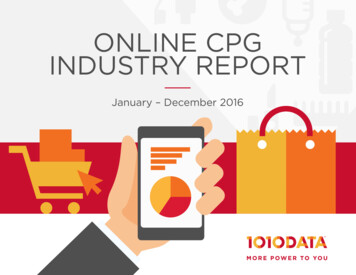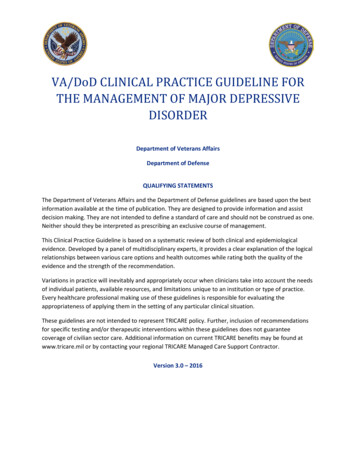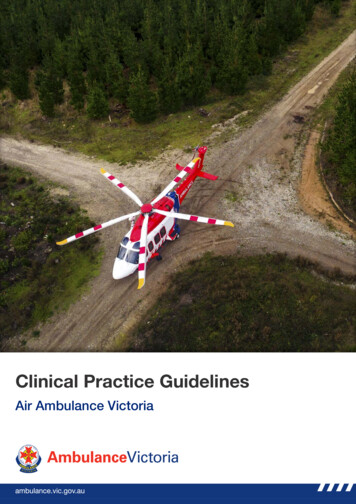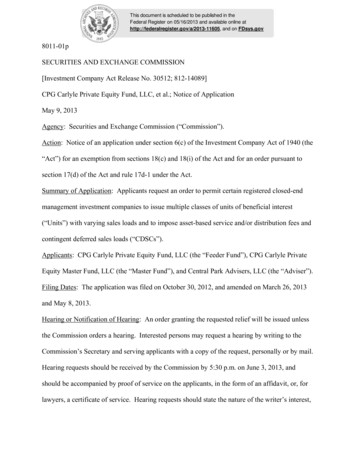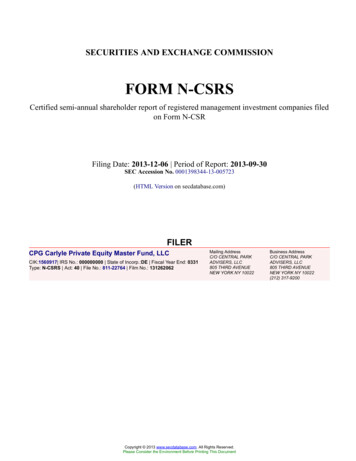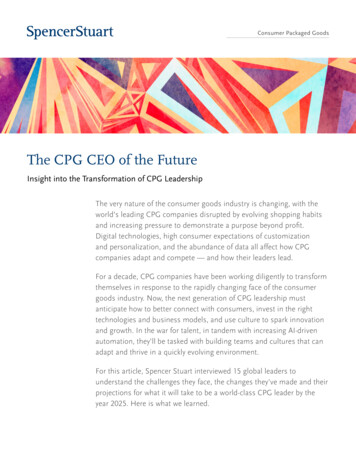
Transcription
Consumer Packaged GoodsThe CPG CEO of the FutureInsight into the Transformation of CPG LeadershipThe very nature of the consumer goods industry is changing, with theworld’s leading CPG companies disrupted by evolving shopping habitsand increasing pressure to demonstrate a purpose beyond profit.Digital technologies, high consumer expectations of customizationand personalization, and the abundance of data all affect how CPGcompanies adapt and compete — and how their leaders lead.For a decade, CPG companies have been working diligently to transformthemselves in response to the rapidly changing face of the consumergoods industry. Now, the next generation of CPG leadership mustanticipate how to better connect with consumers, invest in the righttechnologies and business models, and use culture to spark innovationand growth. In the war for talent, in tandem with increasing AI-drivenautomation, they’ll be tasked with building teams and cultures that canadapt and thrive in a quickly evolving environment.For this article, Spencer Stuart interviewed 15 global leaders tounderstand the challenges they face, the changes they’ve made and theirprojections for what it will take to be a world-class CPG leader by theyear 2025. Here is what we learned.
The CPG CEO of the Future: Insight into the Transformation of CPG LeadershipSafe is now risky: CPG companies must embrace disruptionTraditionally, big CPG companies have been great at mitigating risk and increasing efficiency with data, but not sogreat at using it for agility. They tended to launch safesolutions versus bold category disruptors. But “safe” hasbecome too risky. CPG companies must focus on innovation, driven by more agile development processes andfaster prototyping to mimic startups. The sheer scale ofestablished CPG companies can be an advantage here,because of the resources at their disposal, but only if theyleverage customer data and predictive analytics topinpoint new opportunities and marketing ideas.Some large CPG companies now have a differentapproach to innovation. Jorge Mesquita, former executivevice president and worldwide chairman of Johnson &Johnson, deployed innovation squads called “black opsgroups” to specific regions to explore trends, find outwhat local consumers were looking for and uncover ideassmall competing players were nurturing. He explains theneed to innovate how the company competes on a locallevel: “Startups tend to be single-country companies, sothey feel intensely local, very on-trend and immersed inthe culture and folklore of the country. If you have a globalbrand, each market needs to feel like the brand belongsthere and nowhere else.”Old innovation models took 18 to 24 months fromconcept to launch, but reaching niche audiences has aspeed component. Jean-Marc Duvoisin, CEO ofNespresso, reveals, “If you are not fast, the trend couldbe dead by the time you get to market.” Data-driven innovation can speed the process of getting to market. RamKrishnan, president and CEO, PepsiCo, Greater Chinaregion, says, “You need really rapid innovation enabled bya very flexible supply chain. That is completely gettingdisrupted with data-driven innovation.”Javier Ferran, chairman of the board at Diageo, weighsin on how leaders must react to compete against andeven emulate startups: “The key is to have the agility,speed and entrepreneurship to assemble things yourself. You want to be able to move quickly when you seeyour competitor move.” The biggest benefit startupshave is the ability to execute fast. CEOs who can put inplace mechanisms to move just as quickly in large CPGcompanies will be at an advantage.David Taylor, president and CEO of Procter & Gamble(P&G) describes how his company emulates a startupethos in specific regions from R&D to marketing: “P&Gscientists work in labs in multiple places. Then we showup locally with an organization that’s empowered todevelop local ad copy and local programs to connect thebrand with consumers. Connecting to consumerslocally, we’re seeing 20 percent growth on some brandsthat were not growing before.”Portfolios are expanding to boost revenues and stay relevantSome large CPG companies are diversifying their product lines in order to boost revenues. Mars has movedboldy into all facets of pet health services, Danone intoplant-based nutrition and Coca-Cola into coffee as partof its total beverage strategy. But if you’re going to turna business model on its head, make sure you’re offeringproducts with sticking power.Unilever’s recent acquisition of Dollar Shave Club hasbeen a “great acquisition,” according to CEO AlanJope, because its growing rapidly in double digits,driven by a steady increase in subscriptions and agrowing basket size, as well as providing valuablelearning for the broader business. But Jope warnsSpencer Stuartagainst a fixation on acquisitions: “They’re the icing.The cake remains our core business. If we adopted anattitude that ‘core brands are doomed’ and compensated by buying 100 million-dollar brands, that wouldbe the path to absolute disaster.”Consumers want fresh, new and innovative, and theywant their favorite trustworthy brands. Everything else,they can do without. James Quincey, chairman and CEOof Coca-Cola, says, “The big are getting bigger, and thesmall are becoming in aggregate bigger, and it’s themiddle that’s getting squeezed. If you’re going to dosomething new, it needs to turn into a leader brand.You’re in the innovation game.”page 2
The CPG CEO of the Future: Insight into the Transformation of CPG LeadershipM&A tactics must be aggressive, yet thoughtfulWhen you can’t beat them, sometimes, the smart moveis to join them — or rather, acquire them, like Unileverdid with Dollar Shave Club. For big companies, engaging in M&A makes it easier to compete on a niche leveland provides a symbiosis that smaller companies andstartups also benefit from.Hans Van Bylen, CEO of Henkel, describes how thissymbiosis plays out optimally: “Startups can create smallbusinesses incredibly fast, but creating a billion-dollarbusiness, that's a big step. However, in scaling up multinational consumer goods companies can play a decisiverole. Today, successful companies will be those that canmanage both: small niche brands, acquired or built fromscratch, and big brands. This holds even more true in anincreasingly digitalized world.”Acquisitions enable a big brand with one revenuestream to enter another quickly and with practicedexpertise, as when Coca-Cola recently acquired thecoffee brand Costa Limited, which included thousandsof up-and-running retail outlets. Now, the beverage gianthas an “experience” to offer, which is important in atime when CPG companies are trying to find ways ofengaging consumers through experiences.But Yiannis Petrides, former chairman of the board ofRefresco, warns against trying to absorb smaller companies too thoroughly into the larger organization: “Letthem do their work. Otherwise, you bring them into thislarge bureaucratic organization and destroy the raisond’etre that made them successful in the first place.”For CPG leaders, having the vision to bring in smallerbrands with diversified products must be balanced withthe maturity and wisdom to let them remain somewhatculturally independent.interview participantsAs part of our research for this article, we interviewed current and former CEOs, board chairs andother senior executives of leading consumer packaged goods companies around the world.» Stefan Bomhard, Group CEO, Inchcape» Jean-Marc Duvoisin, CEO, Nespresso» Javier Ferran, Chairman of the Board, Diageo» João Paulo Ferreira, Chief Executive Officer,Natura Cosmeticos» Yiannis Petrides, former Chairman of theBoard, Refresco, former President Europe,Pepsi Bottling Group» James Quincey, Chairman and CEO,Coca-Cola» Grant Reid, President and CEO, Mars» Alan Jope, CEO, Unilever» Aditya Sehgal, COO, RB Health» Ram Krishnan, President & CEO, Pepsico,greater China Region» David Taylor, President and CEO,Procter & Gamble» Jean-Claude Le Grand, Executive VicePresident Human Relations, L’Oréal» Hans Van Bylen, CEO, Henkel» Jorge Mesquita, former Executive VicePresident and Worldwide Chairman,Johnson & JohnsonSpencer Stuart» Jan Zijderveld, CEO, Avonpage 3
The CPG CEO of the Future: Insight into the Transformation of CPG LeadershipValues and purpose are moving to center stageThe biggest CPG companies have built billion-dollarbrands and nurtured them over years. Traditionalbrand-building tactics aren’t going away, but CPGcompanies must recognize and remember thatpurpose is critical. Younger shoppers, with theirdistinct preference for novelty, relevance and authenticity, use their dollars to vote for products they perceiveas meaningful, from healthy brands to born-digitalboutique lines.Grant Reid, president and CEO of Mars, acknowledges,“I've seen a big shift around the level of transparencythat consumers want. There’s a quest for authenticityand for a product as straightforward as a candy bar tohave a backstory.” Businesses should listen to that needand recognize that there is a huge opportunity forpurposeful business to create a better future by howthey do business. The values a company holds now takea prominent role in how it’s perceived. For many established CPG companies, this is a new phenomenon;customers have never asked where the product comesfrom. This is why a lot of owner-led companies arebetter equipped to draw people in through narrative. Toresonate with consumers who look for purpose in everypurchasing decision, companies and brands mustexpress believable values.Defining the purpose so that it encompasses thebreadth of a large company’s offerings can be a challenge. One food company executive we spoke with talksabout the company purpose as “unlocking the power offood.” Under this definition of the company’s purpose,there’s real brand value in offering both traditionallyindulgent chocolate chip cookies, which pack anemotional punch when dipped in a glass of milk, andbespoke food brands like those that help consumersregulate their individual biomes. He says: “There’s aplace for both of them, but you must have a CEO whohas a very high-level, articulate vision for the company.They must be able to give that clear mission to attractand retain leadership, and then design an organizationthat fits that purpose.”Sustainability also remains a theme for CEOs today. Ifleaders are merely paying lip service to sustainability, theywon’t be successful. Instead, they must step forward tobecome authentic leaders in this movement, makingdecisions that set their companies apart from competitors in terms of proactive and innovative sustainabilityinitiatives. Winning companies — those that win withconsumers, in financial markets, and with employees —will thrive at the intersection where culture and purposemeet. Companies that deliver against that blend willperform better in the market and attract the best talent.Leaders must have both global and local experienceThe ability to “think small and local” must be balancedwith global vision in a large CPG company. Leaders onthe fast-track to CEO may come from varied backgrounds, but more and more, having both regionalgeneral manager tenures and experience in global category management leaves them better equipped to leadglobal CPG companies.Here is Reid’s take: “The CEO of the future is going tohave much broader experience than the current CEO.At Mars, we are looking for leaders who are equallycomfortable being a GM, running a factory, understanding key raw materials origins and working indifferent functions and geographies. Agility is key.Future CEOs will also need to be able to build authentic relationships with all stakeholders and be able tocreate value for the business and society.”“ There is a cultural and geographic shift in where leaders of the future comefrom. Young talent from China, Southeast Asia and India bring disruptive skillseven though markets like Europe are far more established.”Spencer StuartAditya Sehgalpage 4COO, RB Health
The CPG CEO of the Future: Insight into the Transformation of CPG LeadershipFlatter, more agile organizationswill be more successfulSiloed, bureaucratic, matrixed organizations don’t lend themselvesto a nimble, startup-like mindset. The bigger the company, themore distant executives become from marketplace realities andthe consumer. At Johnson & Johnson, Mesquita describes a modelof “working squads” to break down the company’s 5 billion U.S.business into smaller teams. A group of people enabled to work“end to end and function directly together are a lot less bureaucratic, a lot less complex. We have to change our work processesand push decision-making down, with smaller teams that operatemore like startups.”When every decision must come from the top, it becomes challenging to tap into innovative ideas that can actually come fromanywhere in the organization. Jope puts it this way: “We’re gettingto the end of the useful life of the conventional models of organization defined by hierarchies, boxes and fixed rules. We’re alreadyexperimenting with, and seeing great results from, different ways ofworking where people assemble around problems based on talentand skills. They solve the problem in a finite period of time withtremendous focus, then disband and move on.”Leaders must be digital,disruptive thinkersThe nature of work is changing rapidly. Gartner reports that by2025, smart robots and drones will take over a third of jobs.As Quincey puts it, “The digital question gets oversimplifiedinto ‘what percentage of your sales are e-commerce,’ but thattremendously oversimplifies how fundamentally digital will transform everything around us.” Today, digital is impacting everythingfrom customer service to the supply chain, which is why he says,“Digital stops being a thing to measure, because it is thebusiness. Digital success now becomes business success.”“ The ability to mobilizepeople means havingmanagers who are not justsmart and see the future,but can actually bring thepeople with them. Thenature of leadership ischanging in our lifetime.”James Quinceychairman and CEOCoca-ColaCPG leaders must be very comfortable thinking digitally, but alsocreatively and on their feet. The latter is perhaps more important.“Even if digital savviness is not there, if you have the right CEO,they know where to go and how to get it,” says Petrides. “But youcan’t just bring in a great digital guy as CEO. Instead, look to whatextent they have changed the paradigm in their business decisionsin the past, and done things that were totally new and disruptive.”That ability to change the paradigm, quickly, will differentiate theCPG CEO of the future.Spencer Stuartpage 5
The CPG CEO of the Future: Insight into the Transformation of CPG LeadershipStill, while the ability to see the big picture and evolveideas quickly is important to leadership, functionalexpertise will remain essential. Jan Zijderveld, CEO ofAvon, says: “I need people in the swimming pool whocan swim. I don’t have time to help them learn.Functional expertise remains really critical. Leadersneed to be agile in their thinking of how the world ischanging, or how the delivery of what they’re doing ischanging due to technology.”It’s highly likely that next-gen CEOs will require both thetechnological backbone and innate creativity to leadsomething transformational. CEOs must have the curiosity and courage to take charge of enacting change.Company culture must become more flexible and open to changeCircling back to the idea of “thinking like a startup,”nothing is more important than the culture that leadersfoster. That culture must welcome agility, stripped asmuch as possible of the bureaucracy that is no longer anasset to any enterprise.One executive describes the importance of gettingculture right this way: “You must be willing to manage,inspire and reward employees in a way that's meaningful versus one-size-fits-all, dumbed-down bureaucracy.That should be the most important thing to a CEO,because at the end of the day, that's the difference.”Culture is highly influenced by leadership, but culturechange is going to be more effective if it’s organic. Inthe words of Jope: “I have this dilemma, which is that Iwant to transform the culture, but I don’t want aculture-transformation program. I believe that culturecomes out of your deeds, not your words.” Jope hopesto lead Unilever so it’s “held up as the role model fordiversity and inclusion, way beyond gender, way beyondrace. I hope we can become famous for becoming themost diverse and inclusive culture of any organization,period. That would be part of a culture I think we’ll needto win in the future.”“ Culture has to be translated into processes, symbols, metrics and rituals, andwe are catching all of those to reshape our culture. If we succeed, then wehave a chance of being one of the incumbents that will transform into the newworld. If we fail, we're going to run the risk of being disrupted.”João Paulo FerreiraChief Executive Officer, Natura CosmeticosLeadership “must-haves” for tomorrow’s CPG CEOWhen asked what elements of leadership he sees as critical to the future of P&G, Taylor says: “As a company with abroad multinational enterprise across many categories, wehave to become much more engaged with our employees,much more agile in structures and operations, and on-theground accountability needs to be increased.”That ground-level attention and agility in operationsmust also be met with an eye “in the cloud” — meaningthat the CPG CEO of the future is digitally savvy, capableof using data to take the company in the direction theconsumer is going. The role of a CPG CEO has alwaysrequired a deep curiosity about consumers. With a focusSpencer Stuarton thoughtful use of data and technology, balanced withan agile startup mindset and a more open culture ofcollaboration, the new CPG CEO will have both the foresight and insight to speak to consumers on a highlypersonal level.As the nature of CPG companies evolves to adapt tomore sophisticated consumer expectations, advancingdigital and data technologies, and increased competition from startups and smaller companies, tomorrow’sleaders will be feet-on-the-ground disruptors with boththe vision and skills to see beyond traditional productand organization archetypes.page 6
The CPG CEO of the Future: Insight into the Transformation of CPG Leadership10 characteristics that will define theCPG CEO of tomorrow12345EntrepreneurialCapable of thinking like anentrepreneur of a startupGrowth-orientedA champion of growth and finding newoccasions for consumption, but not overlyfocused on fast-growth, high-trend productsto the detriment of the core product lineEmphatic about valuePossessing clarity of purpose, with the ability to move it to the center of brand-buildingtactics and across all activities to connectmore deeply with consumersGlobally minded, locally connectedGlobally minded in terms of both visionand, if possible, experience — but alsotapped into local markets and closely intouch with consumer needsInclusiveComfortable empowering others, notstuck in a hierarchical mentality6DisruptiveTransformative beyond simply innovative,with a proven history of showing a willingness to expand thinking and go beyondthe dominant paradigm7Digitally savvy and a student ofdata — but not obsessed with data8Eager to try new things and embracethe learnings from failure910Data-drivenExperimental and curiousAgileWelcoming of ambiguity, with a dynamic,flexible approach to strategic planning;able to course-correct easily and communicate with different groups in different waysTransformationalAble to inspire organic change and transform culture without a playbook“ It's not a ‘big brand’ versus ‘small brand’ battle. It's a ‘relevant’ versus‘irrelevant’ battle. The brands that serve customers best win. But to do that youneed to be close to your consumers, super agile and faster than anyone else.”Jan ZijderveldCEO of AvonSpencer Stuartpage 7
stonBrusselsBuenos fFrankfurtGenevaHong KongAuthorsHoustonFrank Birkel (Munich), Jim Citrin (Stamford), Philiep Dedrijvere (Brussels), Massimo Di Dia(Zurich), Angeles Garcia-Poveda (Paris), Jonathan Harper (London), Joe Kopsick (Miami),Eric Leventhal (Stamford), Antonio Maturo (Geneva), Ricardo Rocco (Miami), HeidiSandreuter (New York) and Jwee San Tan (Singapore)JohannesburgIstanbulLimaLondonLos AngelesMadridMelbourneAbout Spencer StuartAt Spencer Stuart, we know how much leadership matters. We are trusted by organizationsaround the world to help them make the senior-level leadership decisions that have a lastingimpact on their enterprises. Through our executive search, board and leadership advisoryservices, we help build and enhance high-performing teams for select clients ranging frommajor multinationals to emerging companies to nonprofit institutions.Privately held since 1956, we focus on delivering knowledge, insight and results through thecollaborative efforts of a team of experts — now spanning 58 offices, 31 countries and morethan 50 practice specialties. Boards and leaders consistently turn to Spencer Stuart to helpaddress their evolving leadership needs in areas such as senior-level executive search, boardrecruitment, board effectiveness, succession planning, in-depth senior managementassessment and many other facets of organizational effectiveness.For more information on Spencer Stuart, please visit www.spencerstuart.com.Mexico CityMiamiMilanMinneapolis/St. PaulMontrealMoscowMumbaiMunichNew DelhiNew YorkOrange CountyOsloParisPhiladelphiaPragueRomeSan FranciscoSantiagoSão PauloSeattleShanghaiSilicon ValleySingaporeStamfordStay up to date on the trends and topics thatare relevant to your business and career.@Spencer StuartStockholmSydneyTokyoTorontoViennaWarsaw 2019 Spencer Stuart. All rights reserved.For information about copying, distributing and displaying this work,contact: permissions@spencerstuart.com.Washington, D.C.ZürichARCL-CPGCEOFUTURE-052919Social Media @ Spencer Stuart
self. You want to be able to move quickly when you see your competitor move." The biggest benefit startups have is the ability to execute fast. CEOs who can put in place mechanisms to move just as quickly in large CPG companies will be at an advantage. David Taylor, president and CEO of Procter & Gamble




